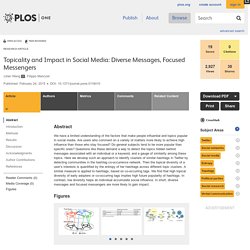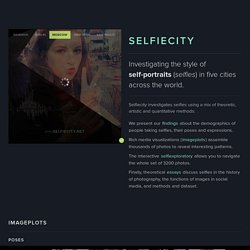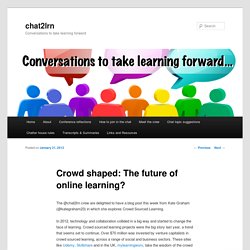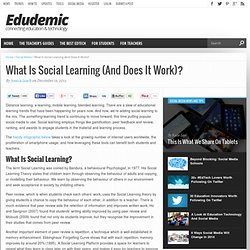

Topicality and Impact in Social Media: Diverse Messages, Focused Messengers. Abstract We have a limited understanding of the factors that make people influential and topics popular in social media.

Are users who comment on a variety of matters more likely to achieve high influence than those who stay focused? Do general subjects tend to be more popular than specific ones? Questions like these demand a way to detect the topics hidden behind messages associated with an individual or a keyword, and a gauge of similarity among these topics.
Here we develop such an approach to identify clusters of similar hashtags in Twitter by detecting communities in the hashtag co-occurrence network. Citation: Weng L, Menczer F (2015) Topicality and Impact in Social Media: Diverse Messages, Focused Messengers. Academic Editor: Renaud Lambiotte, University of Namur, BELGIUM Received: September 14, 2014; Accepted: January 11, 2015; Published: February 24, 2015 Copyright: © 2015 Weng, Menczer. Data Availability: All the data used in the study are available from ( Introduction Fig 1. Selfiecity. The Selfie: Making sense of the “Masturbation of Self-Image” and the “Virtual Mini-Me” Alise Tifentale, The Graduate Center, CUNY This essay reviews some of the most recent debates on the selfie phenomenon and places it into a broader context of photographic self-portraiture, investigating how the Instagrammed selfie differs from its precursors.

The Selfie phenomenon should be viewed in the light of history of photography as a sub-genre of self-portraiture and as a new subject of vernacular photography studies as well as treated as a side product of technological developments that have led to the easy availability of image-making devices and image-sharing platforms. Read the essay Imagined Data Communities Nadav Hochman, University of Pittsburgh Writing about media interface presentations and their relation to larger cultural trends is tricky. Read the essay Beyond Biometrics: Feminist Media Theory Looks at Selfiecity. How to Send Better Email - Without Second-Guessing a Single Word. Have you ever received an amazing email, one that you’d like to print out and pin to your wall, one that made you grin from ear to ear or slow-clap in appreciation and reverence?

When I come across these gems, I drop them into a “Snippets” folder. I study them, I swoon over them, and I borrow bits and pieces of them to send better email. Now imagine that every email you send is as great as these occasional all-stars you receive. Impossible? Not at all. Worth shooting for? At Buffer, we strive for 100 percent awesomeness in the emails we send to customers, and that pursuit of excellence carries over to the emails we send to teammates, colleagues, friends, and family. So I’m happy to share some of my sources of email inspiration. An email template for shaving 20 hours off your work week Author Robbie Abed took to LinkedIn to share a pair of emails that he had used successfully to shave his workweek from 60 hours to 40 hours.
Here is email number one, which is to be sent on Monday. Thank you! Peer Learning Handbook. Crowd shaped: The future of online learning? The @chat2lrn crew are delighted to have a blog post this week from Kate Graham (@kategraham23) in which she explores Crowd Sourced Learning.

In 2012, technology and collaboration collided in a big way and started to change the face of learning. Crowd sourced learning projects were the big story last year, a trend that seems set to continue. Over $70 million was invested by venture capitalists in crowd sourced learning, across a range of social and business sectors. These sites like Udemy, Skillshare and in the UK, mylearningworx, take the wisdom of the crowd (i.e. any Internet user), validate it and share it in one easy to use place. Although quite new, these crowd sourced learning hubs are already offering learners thousands of courses. The background to this rise is the failure of the Internet search engines and social applications to deliver timely, authoritative answers to learning challenges, too often leading students down frustrating blind alleys.
What Is Social Learning (And Does It Work)? Distance learning, e-learning, mobile learning, blended learning.

There are a slew of educational learning trends that have been happening for years now. And now, we’re adding social learning to the mix. The something-learning trend is continuing to move forward, this time putting popular social media to use. Social learning employs things like gamification, peer feedback and review, ranking, and awards to engage students in the material and learning process.
The handy infographic below takes a look at the growing number of internet users worldwide, the proliferation of smartphone usage, and how leveraging these tools can benefit both students and teachers. What Is Social Learning? The term Social Learning was coined by Bandura, a behavioural Psychologist, in 1977. Peer review, which is when students check each others’ work, uses the Social Learning theory by giving students a chance to copy the behaviour of each other, in addition to a teacher.
Does It Work? Big Thinkers on Education.